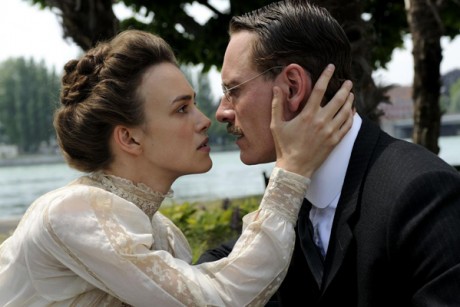A Dangerous Method
Directed by David Cronenberg
Written by Christopher Hampton
United States, Canada, 2011
A Dangerous Method isn’t quite a film that unwraps. That would imply that there’s something complete at the end. It doesn’t exactly unravel. That would imply that it was whole to begin with. Instead, the latest film from one-time B-film maven turned small prestige-picture-helmer, David Cronenberg, shifts, constantly playing with expectations and maneuvering its audience in the same way that its protagonists maneuver their patients.
Carl Jung (Michael Fassbender) is a brilliant psychoanalyst, but finds himself troubled in his inability to truly and accurately treat his patients. Prior to meeting the world-renowned Sigmund Freud (Viggo Mortensen) in their first of many encounters, he successfully treats Sabina Spielrein (Keira Knightly) using Freud’s methods. Freud and Jung meet in 1907 and, though there is an obvious mutual respect, the two egos find themselves increasingly at odds with one another. In 1909, during their famous trip to the United States, the relationship fractures, fundamentally changing the entire face of psychoanalysis.
This is definitely Jung’s movie, though oddly it’s Freud’s philosophy that dominates. As much about their diverging personalities, the film is also about the ushering out of an old, hardened psychology (Freud’s take: the world can’t change and our goal is simply to accept it), and into a newer, eventually post-war, psychology of acceptance (Jung’s take: help the patient).
Cronenberg has mistakenly been taken to task for leaving his head-exploding, ooze-spewing roots for recent films like A History of Violence and Eastern Promises. A Dangerous Method is, however, closer to the sexuality of his 1988 masterpiece Dead Ringers than it is to those Viggo Mortensen mob vehicles. Further, it finds the director taking a technique that felt tired in Eastern Promises – a diary in the form of expositional voiceover – and invigorating it with new life. The voiceover in A Dangerous Method – again letter-writing voiceovers – isn’t simply cheap information (they largely contain information we’re already privy to), but instead allows Cronenberg to devolve a friendship in compressed time, emphasizing the suddenness and surprise of Freud and Jung’s split.
While Cronenberg’s film begins in the midst of Jung’s efforts and offers little in the form of finality, it is the tense presentation and process that makes A Dangerous Method more of a captivating thriller than biopic. Dominated in the first half by tightly framed, split-focus two-shots and a depth of field that recalls early Polanski, Cronenberg deftly navigates the film from a kind of claustrophobic rigidity towards a more open compositional style in its third act. The equation with the narrative – Jung’s struggle with himself and morality in the first half versus his virtual acceptance of his immorality by the end – is lucidly apparent.
The final shot of Jung sitting in a comfortable chair on his estate and staring out to the water in front of him rhymes with Cronenberg’s non-closure close-ups of his recent films. The historical accuracy of this film, however, lends its ending less to an interpretation of intentional vagaries, than to an emphasis on the psychological precipice at which Jung – and consequently the world – found itself at the outset of World War I. This ending is therefore not so much about loneliness or failure (Jung’s prediction of war comes true after all), but rather of the period of psychoanalytical inactivity (read: Jung’s literal stasis) that is impending, but which will ultimately give rise to its rebirth.
Cronenberg’s ability to delicately direct his audience as much as his actors leads to frequent shifts in the balance of power among the principle characters. The ultimate result: a deceptively precise and masterful piece of direction that frequently thwarts expectations despite being a work of non-fiction.
Neal Dhand





